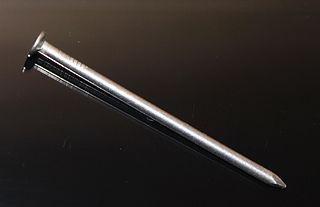
In woodworking and construction, a nail is a small object made of metal which is used as a fastener, as a peg to hang something, or sometimes as a decoration. Generally, nails have a sharp point on one end and a flattened head on the other, but headless nails are available. Nails are made in a great variety of forms for specialized purposes. The most common is a wire nail. Other types of nails include pins, tacks, brads, spikes, and cleats.

Furniture refers to objects intended to support various human activities such as seating, eating (tables), storing items, working, and sleeping. Furniture is also used to hold objects at a convenient height for work, or to store things. Furniture can be a product of design and can be considered a form of decorative art. In addition to furniture's functional role, it can serve a symbolic or religious purpose. It can be made from a vast multitude of materials, including metal, plastic, and wood. Furniture can be made using a variety of woodworking joints which often reflects the local culture.

A futon is a traditional Japanese style of bedding.

Upholstery is the work of providing furniture, especially seats, with padding, springs, webbing, and fabric or leather covers. The word also refers to the materials used to upholster something.

A mattress is a large, usually rectangular pad for supporting a lying person. It is designed to be used as a bed, or on a bed frame as part of a bed. Mattresses may consist of a quilted or similarly fastened case, usually of heavy cloth, containing materials such as hair, straw, cotton, foam rubber, or a framework of metal springs. Mattresses may also be filled with air or water.

A bed is an item of furniture that is used as a place to sleep, rest, and relax.
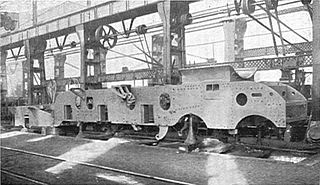
A locomotive frame is the structure that forms the backbone of the railway locomotive, giving it strength and supporting the superstructure elements such as a cab, boiler or bodywork. The vast majority of locomotives have had a frame structure of some kind. The frame may in turn be supported by axles directly attached to it, or it may be mounted on bogies (UK) / trucks (US), or a combination of the two. The bogies in turn will have frames of their own.
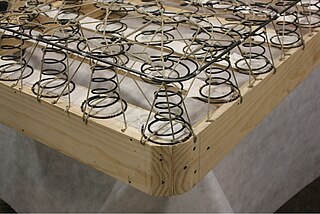
A box-spring is a type of bed base typically consisting of a sturdy wooden frame covered in cloth and containing springs. Usually the box-spring is placed on top of a wooden or metal bedframe that sits on the floor and acts as a brace, except in the UK where the divan is more often fitted with small casters. The box-spring is usually the same size as the much softer mattress that is placed on it. Working together, the box-spring and mattress make up a bed. It is common to find a box-spring and mattress being used together without the support of a frame underneath, the box spring being mounted directly on casters standing on the floor.
Upholstery coil springs are an important part of most modern upholstery. The consumer usually never sees the construction features of an upholstered piece. The overall quality of the materials and construction dictate the comfort level of an upholstered piece and its ability to satisfy the consumer over the long term. A basic upholstered piece may be composed of a frame, springs, foam, cushioning, padding, and textiles.

A sofa bed or sofa-bed is a multifunctional furniture typically consisting of a sofa or couch that, underneath its seating cushions, hides a metal frame and thin mattress that can be unfolded or opened up to make a bed. A western-style futon differs from a sofa bed, although sofa beds using futon mattresses are common.

A daybed is an item of furniture used as a bed as well as for lounging, reclining, and seating in a common room. It may be considered a form of multifunctional furniture. Their frames can be made out of wood, metal or a combination of wood and metal. They are a cross between a chaise longue, a couch, and a bed.
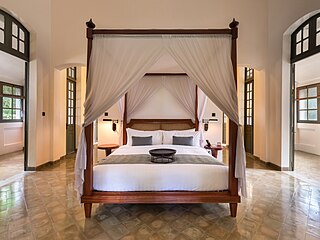
A canopy bed is a bed with a canopy, which is usually hung with bed curtains. Functionally, the canopy and curtains keep the bed warmer, and screen it from light and sight. On more expensive beds, they may also be elaborately ornamental.
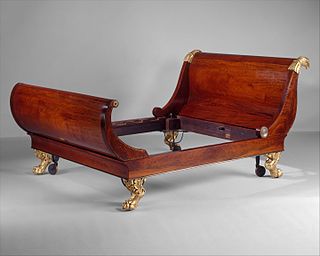
A sleigh bed is a style of bed with curved or scrolled foot and headboards, thus resembling a sled or sleigh.

A vehicle frame, also historically known as its chassis, is the main supporting structure of a motor vehicle to which all other components are attached, comparable to the skeleton of an organism.

A bed base, sometimes called a foundation, is the part of a bed that supports the mattress. The bed base can itself be held in place and framed by the bedstead. In the United States, box-spring bed bases are very common. In Europe, sprung slats are much more common.

A hospital bed or hospital cot is a bed specially designed for hospitalized patients or others in need of some form of health care. These beds have special features both for the comfort and well-being of the patient and for the convenience of health care workers. Common features include adjustable height for the entire bed, the head, and the feet, adjustable side rails, and electronic buttons to operate both the bed and other nearby electronic devices.

Ancient furniture was made from many different materials, including reeds, wood, stone, metals, straws, and ivory. It could also be decorated in many different ways. Sometimes furniture would be covered with upholstery, upholstery being padding, springs, webbing, and leather. Features which would mark the top of furniture, called finials, were common. To decorate furniture, contrasting pieces would be inserted into depressions in the furniture. This practice is called inlaying.

Six-column beam engines are a type of beam engine, where the beam's central pivot is supported on a cast-iron frame or 'bedstead', supported on six iron columns.

The marriage bed of Henry VII is a carved oak four-post bedstead bought in a dilapidated condition at an auction in Chester, England, in 2010. Since then the bed has been subjected to art historical investigation and advanced material analysis. It is suggested that the bed was made to celebrate the marriage of King Henry VII to Elizabeth of York on 18 January 1486.

A storage bed is a multifunctional furniture consisting of a bed which utilizes storage space which often otherwise is lost, for example by having drawers on its underside or a mattress which can be flipped up to access a storage space beneath. It is an example of a storage furniture or multifunctional furniture, and can accommodate more efficient use of living spaces.





















